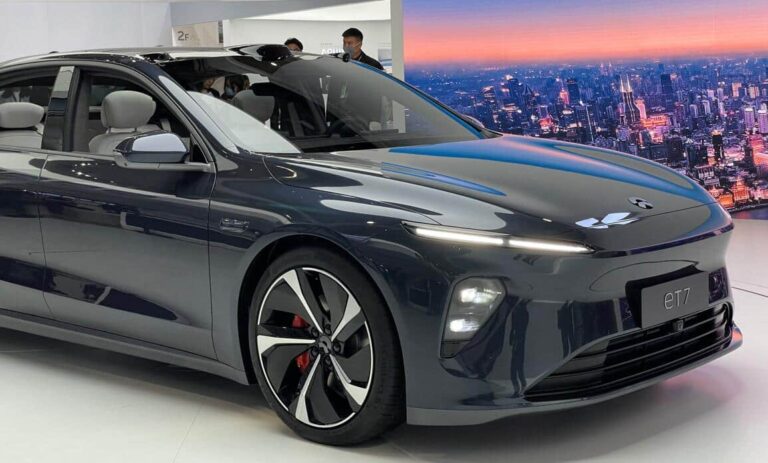The team calls Nio management's long-term strategy the Blue Sky Blueprint, saying it will be a moat for the EV maker, though it's very costly to build.
Nio (NYSE: NIO) has had operational problems over the past year, and multiple disappointing moments that have started to shake many people's confidence in the company.
Edison Yu, a Deutsche Bank analyst who had previously been bullish on the electric vehicle (EV) maker, also expressed disappointment after Nio's fourth-quarter earnings were released. However, that doesn't mean the team's stance has changed.
"Being a Nio bull these days is becoming increasingly difficult. The company’s execution has been lackluster and investors are losing confidence in management’s long term vision and growing concerned about demand and cash burn. So why do we stay the course?" the team wrote in a research note sent to investors today.
The team believes that Nio's operational problems could soon be over after learning a few costly lessons, reigniting growth in the second half of the year.
Moreover, Nio's aggressive deployment of charging and service infrastructure will provide a differentiated user experience that will help drive high customer loyalty and brand awareness.
Coupled with Nio's significant investments in new mass market brands, smart driving capabilities, battery in-sourcing and chips, the team envisions Nio having a strong moat that few automakers will be able to replicate.
"We call this the Blue Sky Blueprint (BSB)," the team wrote.
But Yu's team also notes that it will clearly be quite choppy in the short term, as Nio is set to launch five new models in just four months.
With each incremental step-up, Nio management could regain some investor trust and the stock would recover accordingly, the team said.
Nio reported record fourth-quarter revenue on March 1, but it fell short of Wall Street expectations, and its gross margin plunged to 3.9 percent and its vehicle margin fell to 6.8 percent.
The company said its vehicle margin was negatively impacted by 6.7 percentage points in the fourth quarter due to inventory provisioning, accelerated depreciation of production facilities and the loss of purchase commitments for the current generation ES8, ES6 and EC6.
Even after excluding these one-time headwinds, the 13.5 percent vehicle margin would have been a miss and the lowest since the second quarter of 2020, Yu's team noted.
Nio's guidance of between 31,000 and 33,000 deliveries for the first quarter means that March deliveries are expected to be between 10,337 and 12,337, thus flat or down from February.
In Yu's team's view, Nio's poor sales are due to three main factors:
First, the operational troubles last year caused delays ramping up production of ET7 and ET5.
At the time of unveiling, these were considered the newest trendy electric cars on the market but eventually many customers cancelled because the wait times just got too long and newer competing models hit the market.
For example, we estimated there were at least 60k orders for the ET7 before SOP but by the end of 2022, there were only <25k units delivered, suggesting over half of pre-orders may have been cancelled.
Second, the broader premium segment appears to be electrifying more slowly which may be counter intuitive to those outside China. For example, in both Dec and Jan, the top 5 selling premium sedans in China were all gasoline models from German luxury OEMs.
Third, affluent customers in major urban areas appear to be prioritizing spending outside of autos following the COVID re-open (e.g., traveling, recreation, etc...).
As the year progresses, it's foreseeable that the latter half of the segment will improve significantly if Nio's new model goes into production on schedule and scales up accordingly, according to Yu's team.
As Chinese society adjusts to the new post-zero-Covid norm, there could also be a favorable shift in customer behavior toward high-end BEVs, the team noted.
Nio's management said during the March 1 earnings call that they still believe doubling sales this year is realistic, and that the product portfolio can now support sales of more than 30,000 units per month.
An expensive strategy
Yu's team now refers to Nio management's long-term strategy as the Blue Sky Blueprint (BSB), saying that Nio's establishment of the blueprint proved to be very costly.
A new concern for Nio is cash flow, with the company likely to burn RMB 15 billion to RMB 20 billion this year and another RMB 8 billion to RMB 10 billion in 2024, according to the team.
By comparison, Nio had a net cash position of about RMB 30 billion in the fourth quarter.
" While we don't worry about liquidity, we think the optics are not encouraging," the team wrote.
Nio's R&D, SG&A and capital expenditures are all growing rapidly, but there's little result to show for it. That's because building a true competitive moat is very expensive, the team said.
"Clearly, BSB is a very ambitious road map and investors give them little to no credit for success at the moment but we believe this is the ultimate endgame and will be providing more of our thoughts in future reports," the team wrote.
The team maintains a Buy rating on Nio, saying the company could still win the electric vehicle war once the dust settles.
Nio stock sold off after the earnings report, closing down 5.96 percent in the US on March 1, but continued to rally over the next two days and has recovered its post-earnings losses.


